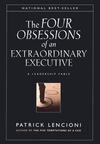|
|
LenFour1
02-3-39 †† THE FOUR
OBSESSIONS OF AN EXTRAORDINARY EXECUTIVE†
A Leadership Fable Patrick
Lencioni |
|
A book in the tradition of The Five Temptations of a CEO
(1998), Lencioni tells a short, interesting (fictional) story to illustrate
his themes.† Lencioni is a speaker and
the president of Table Groups, a management consulting firm.† After the tale, there is a brief
application section. The four ďobsessions,Ē areas where the CEO spent the bulk
of his efforts, are
i. What did
you accomplish?
ii.
What will you accomplish next?
iii.
How can you improve?
iv.
Are you embracing the values? In sum, †††††† Be cohesive †††††† Be clear †††††† Over
communicate †††††† Reinforce For performance reviews, every manager must spend 90
minutes in a room with each employee.†
They take it seriously. The competitive advantage any company can have, but which
is usually ignored, is organizational health.†
It requires a lot of time and attention from executives. Health means less politics and confusion, greater morale
and productivity, less turnover, and lower recruiting costs. The four human systems to institutionalize an
organizationís sense of clarity are
Look for qualities in job candidates that match the values
of the company.† Use psychological
testing and well-designed questions.† Performance management is about communication and
alignment.† In the management reviews,
include only essential information.†
Performance evaluation dialogue is not quarterly but daily and
ongoing. * * * * * * |
|
